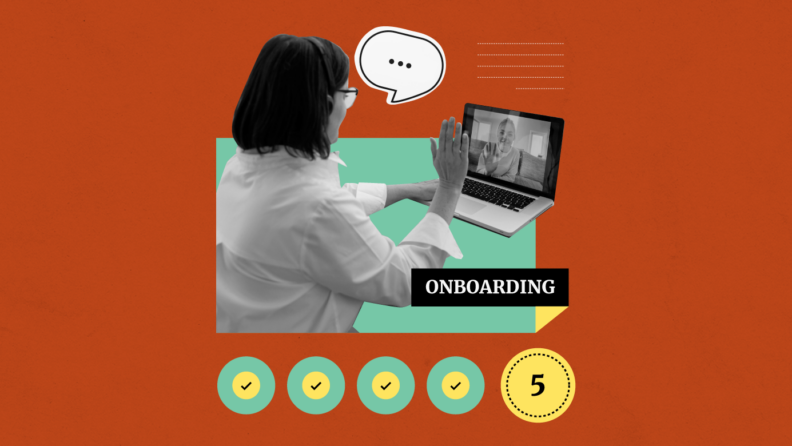As businesses increasingly recognize the benefits of a geographically dispersed workforce, the need for a well-structured remote hiring process has become more critical.
Whether you're a startup aiming to tap into a global talent pool, or an established company adapting to new work norms, this article will guide you through the intricacies of remote hiring, from defining job roles and sourcing candidates to conducting virtual interviews and onboarding new hires.
What Is A Remote Hiring Process?
A remote hiring process is the set of steps companies follow to recruit and onboard remote workers, likely without ever meeting them in person.
It typically includes advertising job openings, conducting video interviews, assessing candidates using digital tools, and completing documentation electronically.
The process relies heavily on technology to facilitate communication, evaluation, and integration of new hires into remote or hybrid teams.
Having a remote hiring process (or any hiring process for that matter) is crucial for ensuring you can find the candidates you need, evaluate them thoroughly and efficiently, and provide a great candidate experience.
How Does A Remote Hiring Process Differ From In-Person?
The remote hiring process will largely mirror your in-person hiring process, but there are a few areas where it will need to be adapted slightly, such as:
1. How you assess soft skills and culture fit
While you may have structured questions, during in-person interviews you’re also able to observe informal moments—body language, small talk, office walkthroughs, and team lunches.
That part of culture fit often emerges organically through those interactions.
A remote setting requires structured behavioral questions and async assessments to uncover communication style, autonomy, and digital fluency.
You often have to gauge cultural alignment through written communication, tone in async replies, and clarity in video calls.
This can assess one part of the culture fit, but not all, so making sure you attempt to create an informal environment is important as well.
2. How you assess hard skills and knowledge
An in-person recruitment process may award more freedom to do creative ideation sessions, whiteboarding and coding discussions in-person.
If the rest of your candidates are coming in-person, then you have to build up the assessment for remote candidates separately.
Skills assessments are often asynchronous—done through online testing platforms, written tasks, or project simulations. This allows flexibility but demands trust in the integrity of the process and clear instructions.
Sometimes online assessment tools and tests can feel very artificial, so you have to think about how to make an assessment for technical skills that truly mimics the work they’ll do. These kinds of tests can be quick to administer and tempting to “save time”, but are they really valuable?
For example, you may get more value out of seeing actual code and how candidates approach problem-solving vs. giving them a multiple choice test which tests their recall and whether they have memorised every single piece of syntax in a particular language. You cannot rely on just a quiz to see how this person codes, especially if you won’t see the person day-to-day..
Even in a remote setting, when you are not sure what experience candidates have from across the globe (e.g. not familiar with the companies), looking at a bit of code they have produced is a lot more insightful than a memory exercise.
3. Evaluator alignment and mitigation
In-person interviewers may rely more on gut feeling or real-time discussion, and alignment can happen quickly post-interview through hallway chats, increasing the risk of unconscious bias.
During remote interviewing, bias can creep in due to poor lighting, bad connections, or different home setups.
Here is a quote from a remote interviewer I once had to coach: “Well their lighting and framing was awful, they did not know their angle at all, but their experience I guess makes up for that. We will give them a budget for a new camera and teach them where to place it.”
Is the candidate’s lighting not on par with a beauty influencer? Do they have too much Lego in their background? Not relevant at all to their work and, if anything, Lego is cool!
Additionally, not every interviewer has experience running remote interviews to be comfortable making a decision as they may feel like they have “missed something” if the person is not in front of them.
4. Candidate experience
Candidates can recover first impressions more easily while in-person, and your office environment and hospitality contribute to their overall feeling of the organization.
Communicating in person can capture the nuances of human communications a lot more, and sound less harsh and better contextualised.
Using only digital communications might mean you don’t come across as warm as you want to be and that may hinder the candidate experience.
Further, in a remote setting, every interaction is "on record"—email tone, latency in replies, and tech setup matter.
A slick, well-coordinated virtual process reflects well; delays or tech hiccups do the opposite.
5. Process transparency and communication
Candidates may naturally pick up cues about process or team dynamics from being on-site, even if communication is less formalized.
Communicating the process in a remote setting requires intentional clarity: timeline, next steps, and expectations must be documented and reiterated.
Also, ghosting is more damaging when digital-only. It can be quite liberating to have a strict comms schedule, as both parties know what to expect and when, but of course you have to adhere to that.
6. Onboarding starts earlier
During in-person processes, onboarding is often treated as a separate, post-hire phase with more reliance on co-located mentorship and real-time troubleshooting.
In remote hiring, your process must double as a soft onboarding. Candidates judge your async clarity, documentation quality, and communication tools as proxies for your work environment.
How To Prepare For Remote Hiring
If you already have a process for hiring in-person, congratulations, you have a foundation to build on. If you don’t have a process at all, still great, it means you have a blank canvas!
Bear in mind a lot of these practices are essential for in-person interviewing as well as remote, but here I’ll cover how they specifically benefit remote hiring.
Here’s how to set up your remote hiring process:
1. Define job requirements and expectations
When preparing to hire remotely (or non-remotely for that matter), it's crucial to clearly define job roles, responsibilities, and expectations.
Remote positions often require proactive communication skills, self-motivation, and the ability to work independently.
Clearly outlining these requirements helps attract candidates who are well-suited for remote work environments.
2. Create a remote-friendly job description
Writing an effective job description for remote positions involves highlighting remote-specific benefits like flexible hours and geographic independence.
From a candidate perspective, emphasize communication expectations, preferred time zones, and any necessary technical requirements to ensure alignment between the company's needs and the candidate's capabilities.
3. Get clear on your interview and assessment process
Now that you have your expectations, get granular on how you will assess candidates on whether they meet your expectations.
Make sure you have answers to these questions:
- Who will run each interview?
- What will be covered during each interview e.g. technical skills, culture fit, a particular subset of values?
- How long will each interview run?
- What are the expectations of each interviewer to know about the candidate after each interview?
- How is feedback recorded?
- Will the interviews themselves be recorded (it is easier in a remote setting, but is it necessary?)
- What assessments will be needed (code review, task challenge, presentation etc.)? How will they be administered and submitted by the candidate?
- How will hiring decisions be made?
- Who communicates to candidates throughout the interview and any potential offer (sometimes you want HR/Talent to handle everything, other times you want to split where the offer is delivered by the manager)?
4. Train interviewers on how to run effective interviews remotely
It’s not a given that an interviewer who is great and insightful in-person can translate that experience to entirely-remote interviews.
Sometimes interviewers have created habits of relying overly on things which are difficult to assess over a video conference e.g. body language or eye contact.
If we take eye contact as an example, not everyone will keep eye contact with the camera.
Some people feel more comfortable when looking at the person on their screen to connect with them vs. directly to the camera.
This shouldn’t count as “They didn’t make eye contact and therefore (insert any conclusion about their fit/skill)”.
Unless, of course, you’re interviewing for an on-camera person—at that point maybe remind them to look at the camera and see how it goes.
5. Set up the right tools and technology
Successful remote hiring relies on leveraging the right tools and technology. Video conferencing (VC) platforms facilitate virtual interviews, while applicant tracking systems (ATS) streamline the recruitment process.
For example via the ATS you can set up emails to be automated when they get moved through the process to keep them updated on where they are at any time. You can also connect them to a calendar/VC provider to make sure the link is easily accessible by the candidate.
Collaboration tools like Slack or Asana or Notion foster team communication and project management—essential for remote teams' success.
Lastly, Miro, FigJam and Mural can help with any creative, ideation and whiteboard sessions you may want to do online.
6. Get Legal support
Depending on jurisdiction you may need additional legal support to create a contractor or employee relationship. Some legal systems have stricter differentiations between contractor and employee and others are more laissez-faire.
My recommendation is to have a standard contractor agreement which is valid in a few jurisdictions and then when you identify someone from a region you are not familiar with, check when they get closer to the last stages.
Alternatively there are many employer of record/contracting solutions with standardised templates per-jurisdiction if you would like to automate the advice.
Sourcing And Attracting Remote Talent
Finding and attracting remote talent, like with non-remote, means meeting candidates where they’re at. Here are some tactics and strategies.
Remote-specific job boards
There are quite a few remote jobs boards that cater to remote job opportunities.
That way you can access candidates who are more likely to be experienced already working and excelling in a remote environment.
Here are a few examples:
In addition, the classic job boards like LinkedIn and Indeed have started creating more features to cater to remote jobs such as posting remote roles in more destinations.
Leverage social media and networking
Social media as a recruiting tool is growing in popularity. Platforms like LinkedIn, Twitter, Facebook, and even Slack can help you reach remote candidates by engaging with relevant communities and groups (just check they allow recruiting activities first).
You can also share job postings, and showcase your company's remote work culture to attract passive candidates interested in remote opportunities.
It’s a classic route but it is a classic for a reason—it works.
Employee referral programs
Implementing an employee referral program encourages current employees to recommend qualified candidates for remote positions. Referrals often result in higher-quality hires who are a good cultural fit and can contribute effectively to remote teams.
In a remote hiring setting you may not get as many candidates from employee referrals as from direct applications, but if you have identified one good candidate, they are bound to know more or at least more places you can get candidates like them.
That way you can use the employee referral programmes to get familiar with areas of the global talent market (e.g. you hire people in Brazil and can get to know the local talent market through the,).
Screening And Interviewing Remote Candidates
Once you identify candidates for a remote position, you then have to go through a process of screening and interviewing that is a little different than how you did this a decade ago.
We’ll look at this in a step by step manner.
Application
The modern school of thought is to make applications as streamlined as possible and I align with that.
Nevertheless, in a remote setting, there are a few areas where some extra questions during the application stages are useful.
During application for a remote role specifically do ask the following things:
- Confirm if the candidate has the right to work where they are applying from (i.e. you can’t sponsor visas, which is the most likely case)
- Confirm the candidate is able to be online at the hours you request in the timezone you require.
- Check with the candidate what their salary expectations are (either in their own currency or more international currency like USD/EUR/GBP). Also confirm salary expectations per specific period (monthly or annual).
- Potentially verify if they have experience working in a remote environment (optional).
As you can see, the recommendations above are more around the logistics of working remotely, not about the role itself (that should be something that you screen and interview for).
Screening
Screening is an art and a science. If you’ve managed to combine the two for in-office roles, then you can use most of the same patterns in screening candidates for remote roles.
However, there are a few things I’d add when screening candidates for remote-only roles in addition to the regular screening on whether a candidate is suitable for a role.
Verify logistics
Talk to each candidate about the logistics of employment like:
- Is this person set up to work remotely if from a different country (e.g. set up as a contractor, do they have stable internet?).
- Check salary expectations: Very often candidates in low-cost of living areas may see a very high salary posted and expect that but you may have a different banding for their location. Explain that from the earliest moment possible and have a discussion.
Check remote experience
During the initial screen, you can include a check on how exactly they worked remotely at other companies (if they’ve said so).
If they haven’t, ask how they’d adjust their work style to make sure they are just as productive and communicative.
Confirm company expectations
If your company has any specific expectations, e.g. you are fully remote but gather in the same location once a quarter, or you have specific communication expectations, make sure you discuss them during the initial screening call.
Conducting remote interviews
Conducting remote interviews requires careful planning. You’ll want to establish a structured interview process using video conferencing for face-to-face interactions to allow candidates an opportunity to show their communication style and ability to work remotely.
Ensure all interviewers are aligned on evaluation criteria and what their role in the hiring process is.
If you have a collaborative hiring process, creating a consistent interview experience regardless of who the candidate is interacting with is an important part of developing your employer brand and a positive rapport with new hires.
This, of course, is important in all interviews, but especially vital to remote workers that may not feel as connected to their colleagues over the course of their regular work.
Additionally, you may want to make sure your interviewing team equally understands that interviewing remotely means they will likely come up against very different communication styles which are influenced by cultural nuances.
Some candidates may speak a lot, some not so much in the formal setting of an interview so it is important to be able to cut through that and see the actual skill/experience of the person.
The book The Culture Map by Erin Meyer is a pretty good primer on what to watch out for. It’s not a guarantee that someone from X culture will be like that, but it can be helpful to know.
Assessing technical and soft skills
Evaluate both technical skills relevant to the job and soft skills crucial for remote work, such as time management, collaboration, and adaptability.
Assessing these skills ensures candidates can thrive in a remote work environment and contribute effectively to remote teams. Some examples of skill assessments might include:
- Coding challenges and whiteboarding sessions
- Here you have the option to either do a live coding session or give them code to prep beforehand. Recently I’ve seen a combo of both - prep some code, discuss and correct during the video call. This may give you a more rounded view. Some candidates may not do well when put on the spot, but if you have a lot of pair coding in your software engineering practice, then this would be something to consider.
- Writing samples
- Make sure this is relevant to the role e.g. for a customer service role, go for a client response, not for prose!
- Presentation decks outlining approach to role
- Again make them related to the work, but make sure it’s not something you are currently trying to solve. Don’t ask candidates for free work!
- Simulated work scenarios.
- This one is a bit difficult to re-enact online, but it can work in certain scenarios. Be mindful that you will have to give a lot more context than other times.
Decision and Offer
Okay, the hard part is done. You’ve interviewed a good number of candidates and you’ve narrowed it down to a few strong ones who check the boxes for what you need from the person who ultimately fills the role. Now, it’s decision time.
Here are the next steps in your process.
Extending the job offer
When extending a job offer to a remote candidate, provide clear, detailed contract terms, including salary, benefits, and remote work policies.
Reiterate that the offer is matching/exceeding the previously discussed salary expectations and your localised market offer (this should reflect the conversation you had with them during the screening call).
Make sure you also check if the person over the course of the interview process has set up what they need to be able to work for you - e.g. if they need to set themselves up as a contractor or self-employed if you cannot employ them as an employee.
Checking references
Conduct reference checks just as you would with any other candidate to validate qualifications and assess their past performance and work ethic.
The only additional component in this case is asking about how the person was able to work remotely.
Prepare specific questions related to remote work capabilities and collaboration to gather insightful feedback from referrals.
If you do any “hidden” referencing—which I do not recommend—I doubly do not recommend it in remote settings.
You may not be at all familiar with companies and customs outside your location and culture, so it’s best to avoid the practice altogether.
Onboarding Remote Employees
If your offer is accepted, it’s on to the next step; onboarding. As mentioned, onboarding should start way before day 1, especially if day 1 is not going to be on-location!
In some locations they may have a notice period that can be well over a month so you would want to keep in touch with them during that time. Maybe invite them for a quick virtual coffee with their future teammates.
A week or two before you can send them a welcome email with explanations of:
- The onboarding process
- Equipment delivery
- Week 1
- Buddy
- A rough 30, 60, 90 day plan.
Preparing for day one
Before a remote employee's first day, ensure all necessary accounts, tools, and equipment are set up and provide access to company resources and establish communication channels to facilitate a smooth transition.
Make sure on day 1 you have a way to announce their joining to the whole company (e.g. on Slack or teams) where colleagues from across the company can say hello.
Celebrate the fact that they have joined!
Virtual onboarding process
A structured virtual onboarding process will include virtual orientations, training on company policies and tools, and introduce new hires to their remote team members to foster connection and collaboration.
Ongoing support and integration
Offer ongoing support to remote employees to help them navigate challenges and feel integrated into the company culture.
Schedule regular check-ins, provide opportunities for professional development, and encourage participation in virtual team activities to foster a sense of belonging.
Small gestures
Small things can be the best way to make sure they get the company experience fully even if they are not next to you. Here are a few ideas of what I’ve done previously:
- A candidate mentioned that they make jewelry, but were unable to make earrings as the tools are not readily available in their country, so I included a small earring making kit in the welcome pack.
- Include a full company branding kit so they can wear a t-shirt/sweater on their first day to feel part of the company (ask for size beforehand).
- Record a personalized welcome to open up when they first open their laptop (which may not be exactly on day 1, it may be before!).
These are just a few examples, but have a think about what would make someone feel welcome in your company
Best Practices for a Successful Remote Hiring Process
Like any other process, a good remote hiring process is a reflection of a company culture. To make it more effective and attractive to remote candidates, adopt these three best practices into your process.
Leverage asynchronous communication
Asynchronous communication allows team members and candidates to contribute and respond at their convenience, which is particularly useful across different time zones.
Provide timeframes for responses so that candidates aren’t left waiting, but inform candidates that asynchronous communication is a company value that will be applied in this process.
This approach reduces the pressure of immediate responses and allows for more thoughtful and thorough contributions.
My favourite tool to use is Loom. Say, for example, I need to introduce 5 candidates to a manager, but we’re both in back-to-back meetings with no overlap for us to meet. Here I’d record a quick loom and the manager reviews them, reviews the CVs separately, and comes back to me with questions.
They’re better prepared having reviewed the context and, when we catch up, we can immediately start discussing candidates’ experience vs. spend time explaining.
Continuous improvement
Continuously evaluate and refine your remote hiring process based on candidate feedback and recruitment performance metrics.
Identify areas for improvement, opportunities to automate or implement new technology solutions, and adapt to evolving remote work trends to optimize hiring outcomes.
Especially when it comes to the small gestures and touches—those can be really well sourced from your colleagues. For example, of the small gestures I mentioned above, two came from colleagues during regular feedback sessions I ran with everyone who joined the company.
Inclusive job descriptions
Remote hiring opens access to a global and diverse talent pool, so it's essential to write inclusive and accessible job descriptions.
Avoid jargon or overly corporate language, and emphasize skills over specific backgrounds or degrees.
Clearly state that the role is remote-friendly, including any location preferences or work-hour expectations to prevent confusion.
When possible, include details about accommodations and flexible arrangements to signal inclusivity.




